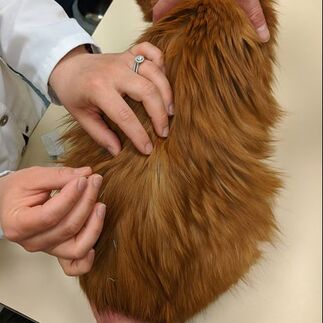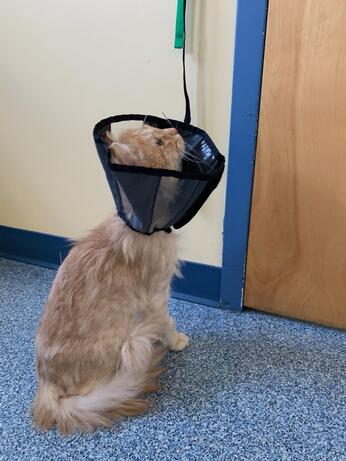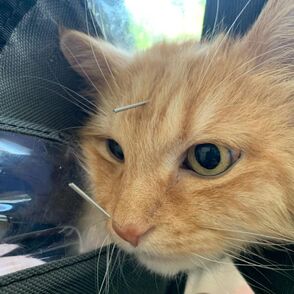AcupunctureDr. Nicole Young is certified in Veterinary Acupuncture with the International Veterinary Acupuncture Society. At Stratham-Newfields Veterinary Hospital, we only offer acupuncture for our own patients. We believe that acupuncture is part of an integrated pet care plan that takes all aspects of our patients' health into consideration.
Did You Know?
|
|
What is Veterinary Acupuncture?
Acupuncture may be defined as the insertion of needles into specific points on the body to cause a desired healing effect. This technique has been used in veterinary practice in China for at least 3000 years to treat many ailments. The Chinese also use acupuncture as preventive medicine against such problems as founder and colic in horses. Acupuncture is used all over the world, either by itself or in conjunction with Western medicine, to treat a wide variety of maladies in every species of domestic and exotic animals. Modern veterinary acupuncturists use solid needles, hypodermic needles, bleeding needles, electricity, heat, massage and low power lasers to stimulate acupuncture points. Acupuncture is not a cure-all, but can work very well when it is indicated. |
Isaac |
Isaac has intestinal lymphoma and inflammatory bowel disease. While his cancer is in remission, he has severe scar tissue in his stomach and intestines that affects his appetite. Along with his other medication, he is receiving acupuncture to help stimulate his appetite.
The soft Elizabethan collar keeps him from rubbing the needles out while allowing him to walk around the exam room during treatment. The teeny-tiny needles may look weird, but he doesn't mind at all! |
Q: For which conditions is acupuncture indicated? |
Acupuncture is indicated mainly for functional problems such as those that involve paralysis, noninfectious inflammation (such as allergies), and pain. For small animals, the following are some of the general conditions which may be treated with acupuncture:
|
Q: How does acupuncture work? |
According to ancient Chinese medical philosophy, disease is the result of an imbalance of energy in the body. Acupuncture is believed to balance this energy and thereby assist the body to heal disease.
In Western terms, acupuncture can assist the body to heal itself by effecting certain physiological changes. For example, acupuncture can stimulate nerves, increase blood circulation, relieve muscle spasm, and cause the release of hormones, such as endorphins (one of the body's pain control chemicals) and cortisol (a natural steroid). Although many of acupuncture's physiological effects have been studied, many more are still unknown. Further research must be done to discover all of acupuncture's effects and its proper uses in veterinary medicine. |
Q: Is acupuncture painful? |
For small animals, the insertion of acupuncture needles is virtually painless. The bigger needles necessary for large animals may cause some pain as the needle passes through the skin, however, in all animals, once the needles are in place, there should be no pain. Most animals become very relaxed and may even become sleepy. Nevertheless, acupuncture treatment may cause some sensations, presumed to be those such as tingles, cramps, or numbness which can occur in humans and which may be uncomfortable to some animals.
|
Q: Is acupuncture safe for animals? |
Acupuncture is one of the safest forms of medical treatment for animals when it is administered by a properly trained veterinarian. Side effects of acupuncture are rare, but they do exist. An animal's condition may seem worse for up to 48 hours after a treatment. Other animals may become sleepy or lethargic for 24 hours after acupuncture. These effects are an indication that some physiological changes are developing, and they are most often followed by an improvement in the animal's condition.
|
Q: How long do acupuncture treatments last and how often are they given? |
The length and frequency of acupuncture treatments depends on the condition of the patient and the method of stimulation that is used by the veterinary acupuncturist. Stimulation of an individual acupuncture point may take as little as 10 seconds or as much as 30 minutes. A simple acute problem, such as a sprain, may require only one treatment, whereas more severe or chronic ailments may need several or several dozen treatments.
When multiple treatments are necessary, they usually begin intensively and are tapered to maximum efficiency. Patients often start with 1-3 treatments per week for 4-6 weeks. A positive response is usually seen after the first to third treatments. Once a maximum positive response is achieved (usually after 4-8 treatments), treatments are tapered off so that the greatest amount of symptom free time elapses between them. Many animals with chronic conditions can taper off to 2-4 treatments per year. Animals undergoing athletic training can benefit from acupuncture as often as twice a week to once a month. The frequency depends on the intensity of the training and the condition of the athlete. |
Q: How should I choose an acupuncturist for my animals? |
There are two important criteria you should look for in a veterinary acupuncturist:
In most countries, states, and provinces, veterinary acupuncture is considered a surgical procedure that only licensed veterinarians may legally administer to animals. A veterinarian is in the best position to diagnose an animal's health problem and then be able to determine whether an animal is likely to benefit from an acupuncture treatment, or whether its problem requires chemical, surgical, or no intervention. In the USA, the American Veterinary Medical Association considers veterinary acupuncture a valid modality within the practice of veterinary medicine and surgery, but extensive educational programs should be undertaken before a veterinarian is considered competent to practice acupuncture. Ask your veterinarian about their training. The more your veterinarian knows about the traditional Chinese philosophies and Western scientific bases for acupuncture, the more sure you can be that your animals will be treated properly. |
Adapted from and with special thanks to The International Veterinary Acupuncture Society for help with the content of this page.




